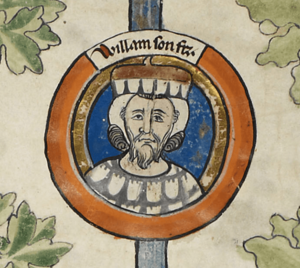William Longsword facts for kids
Quick facts for kids William Longsword |
|
|---|---|
 |
|
| Count of Rouen | |
| Reign | 927–942 |
| Predecessor | Rollo |
| Successor | Richard I |
| Born | c. 893 Bayeux or Rouen |
| Died | 17 December 942 (aged 48–49) Picquigny on the Somme |
| Burial | Rouen Cathedral |
| Spouse | Luitgarde of Vermandois Sprota |
| Issue | Richard I of Normandy |
| House | Normandy |
| Father | Rollo, Count of Rouen |
| Mother | Poppa of Bayeux |
William Longsword (born around 893 – died 17 December 942) was an important leader in Normandy. He was the second ruler of the area we now call Normandy. He led from 927 until he died in 942.
People sometimes call him the "Duke of Normandy." But the title "duke" wasn't commonly used until the 11th century. During his time, William was known as the Count of Rouen. Historians like Flodoard called him a "chieftain" of the Normans.
Contents
William Longsword's Early Life and Family
William Longsword was born "overseas." His father was Rollo, a Viking leader. His mother was Poppa of Bayeux. Some stories say Poppa was the daughter of a powerful count named Berengar. Other records suggest her father was Guy, Count of Senlis. Her exact family background is not fully known.
William became a Christian, likely at the same time as his father. This happened around 912. Franco, Archbishop of Rouen baptized them.
Becoming the Leader of Normandy
William took over from his father, Rollo, in 927. Rollo lived for about five more years after that. Early in his time as leader, William faced a challenge. Some Normans felt he was becoming too much like the French.
How William Handled a Rebellion
A leader named Riouf of Evreux led a rebellion against William. Riouf and his followers surrounded William in Rouen. William bravely led his forces out of the city. He won a big battle, showing everyone he was in charge. During this time, in 933, William sent his wife, Sprota, to safety. Their son, Richard, was born there.
Expanding Norman Lands and Alliances
In 933, William recognized Raoul as the King of Western Francia. King Raoul was trying to gain control in Northern France. In return for William's support, King Raoul gave him control over many lands belonging to the Bretons. These lands included Avranches, the Cotentin Peninsula, and the Channel Islands.
Conflicts with the Bretons
The Bretons did not like these changes. They fought back against the Normans. Alan II, Duke of Brittany, and Count Berengar of Rennes led their resistance. But the fighting ended quickly. Many Bretons were killed, and their castles were destroyed. Alan fled to England, and Berengar decided to make peace.
William's Marriages and New Friends
In 935, William married Luitgarde. She was the daughter of Count Herbert II of Vermandois. As part of her marriage gift, William received lands like Longueville, Coudres, and Illiers-l'Évêque. He also arranged for his sister, Adela (also known as Gerloc), to marry William, Count of Poitou. This marriage was approved by Hugh the Great.
William was now a loyal friend to King Raoul and his father-in-law, Herbert II. This was a change, as his own father, Rollo, had been against them.
Supporting a New King
In January 936, King Raoul died. Louis IV, who was 16 years old, was living in England. William promised to be loyal to Louis. Because of this promise, Louis returned and became the new king. After this, the Bretons tried to get back the lands the Normans had taken. This led to more fighting in the expanded Norman territories.
Challenges and Death
The new King Louis IV found it hard to control his powerful nobles. In 939, William's brother-in-law, Herluin II, Count of Montreuil, was attacked by Flanders. William went to help him. In response, Arnulf I, Count of Flanders attacked Normandy. Arnulf captured the castle of Montreuil-sur-Mer and forced Herluin out. William and Herluin then worked together to take the castle back.
William was temporarily removed from the Christian church (excommunicated) for attacking and destroying some of Arnulf's lands. In 940, William promised his loyalty to King Louis IV. In return, King Louis confirmed that William could keep the lands his father, Rollo, had been given.
In 941, a peace agreement was made between the Bretons and Normans. King Louis IV helped arrange this in Rouen. The agreement limited how much the Normans could expand into Breton lands.
The next year, on 17 December 942, William was at a peace meeting. This meeting was held on an island in the Somme at Picquigny. During the meeting, William was attacked and killed by followers of Arnulf. They were trying to settle their disagreements.
William's Family and Successor
William did not have any children with his Christian wife, Luitgarde. He had one son, Richard, with Sprota. Richard was 10 years old when William died in December 942. Richard then became the new Ruler of Normandy.
See also
 In Spanish: Guillermo I de Normandía para niños
In Spanish: Guillermo I de Normandía para niños


